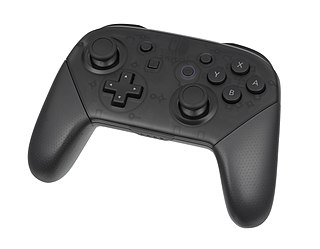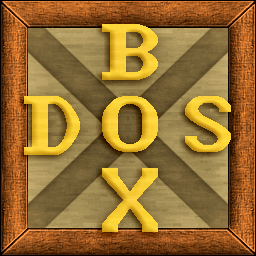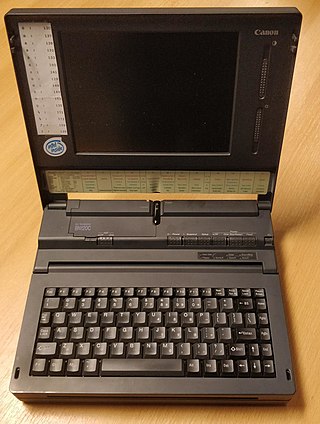
Amiga is a family of personal computers introduced by Commodore in 1985. The original model is one of a number of mid-1980s computers with 16- or 16/32-bit processors, 256 KB or more of RAM, mouse-based GUIs, and significantly improved graphics and audio compared to previous 8-bit systems. These systems include the Atari ST—released earlier the same year—as well as the Macintosh and Acorn Archimedes. Based on the Motorola 68000 microprocessor, the Amiga differs from its contemporaries through the inclusion of custom hardware to accelerate graphics and sound, including sprites and a blitter, and a pre-emptive multitasking operating system called AmigaOS.

A joystick, sometimes called a flight stick, is an input device consisting of a stick that pivots on a base and reports its angle or direction to the device it is controlling. A joystick, also known as the control column, is the principal control device in the cockpit of many civilian and military aircraft, either as a centre stick. It has various switches to control the movements of the aircraft controlled by the Pilot and First Officer of the flight.

A sound card is an internal expansion card that provides input and output of audio signals to and from a computer under the control of computer programs. The term sound card is also applied to external audio interfaces used for professional audio applications.

The Gravis PC GamePad is a game port game controller produced by Advanced Gravis Computer Technology first released in 1991. It was the first gamepad for the IBM PC compatible in a market then dominated by joysticks. Included with the gamepad was a shareware Commander Keen game, episode 1, Marooned on Mars, which was later replaced with the shareware episode 4, Secret of the Oracle which supported all 4 buttons. The gamepad is no longer manufactured, as Gravis was acquired in 1997 by Kensington Computer Products Group.

A game controller, gaming controller, or simply controller, is an input device or input/output device used with video games or entertainment systems to provide input to a video game. Input devices that have been classified as game controllers include keyboards, mice, gamepads, and joysticks, as well as special purpose devices, such as steering wheels for driving games and light guns for shooting games. Controllers designs have evolved to include directional pads, multiple buttons, analog sticks, joysticks, motion detection, touch screens and a plethora of other features.

Microsoft SideWinder was the general name given to the family of digital game controllers developed by Microsoft for PCs. The line was first launched in 1995. Although intended only for use with Microsoft Windows, Microsoft SideWinder game controllers can also be used with macOS, Mac OS 9 with third-party software, and Linux.
Cirque Corporation is an American company which developed and commercialized the first successful capacitive touchpad, now widely used in notebook computers. Cirque develops and sells a variety of touch input products, both in original equipment manufacturer and end-user retail form. Cirque was founded in 1991 by George E. Gerpheide, PhD, and James L. O'Callaghan, to commercialize the GlidePoint technology invented in the 1980s by Gerpheide.

A gamepad is a type of video game controller held in two hands, where the fingers are used to provide input. They are typically the main input device for video game consoles.
Ensoniq Corp. was an American electronics manufacturer, best known throughout the mid-1980s and 1990s for its musical instruments, principally samplers and synthesizers.

The Gravis UltraSound or GUS is a sound card for the IBM PC compatible system platform, made by Canada-based Advanced Gravis Computer Technology Ltd. It was very popular in the demoscene during the 1990s.

DOSBox is a free and open-source emulator which runs software for MS-DOS compatible disk operating systems—primarily video games. It was first released in 2002, when DOS technology was becoming obsolete. Its adoption for running DOS games is widespread, with it being used in commercial re-releases of those games as well.
A multitap is a video game console peripheral that increases the number of controller ports available to the player, allowing additional controllers to be used in play, similar to a USB hub or a power strip. A multitap often takes the form of a box with three or more controller ports which is then connected to a controller port on the console itself.

Intellivision Lives! is a compilation of over 60 Intellivision video games, originally produced by Mattel Electronics and INTV Corporation between 1978 and 1990. Using original game code and software emulation, Intellivision Productions released the compilation on a Windows and Macintosh hybrid CD-ROM in December 1998. Additional versions were then released for the PlayStation 2, Xbox, and GameCube by Crave Entertainment. In 2010, Virtual Play Games released a Nintendo DS version.
ACCO Brands Corporation is an American multinational company and is one of the world's largest designers, manufacturers, and marketers of premium business, technology, academic, and consumer products. It was created by the merger of ACCO World from Fortune Brands with General Binding Corporation (GBC).

Creative Technology Ltd., or Creative Labs Pte Ltd., is a Singaporean multinational technology company. The principal activities of the company and its subsidiaries consist of the design, manufacture and distribution of digitized sound and video boards, computers and related multimedia and personal digital entertainment products. It also partners with mainboard manufacturers and laptop brands to embed its Sound Blaster technology on their products.

ASUSTeK Computer Inc. is a Taiwanese multinational computer, phone hardware and electronics manufacturer headquartered in Beitou District, Taipei, Taiwan. Its products include desktop computers, laptops, netbooks, mobile phones, networking equipment, monitors, Wi-Fi routers, projectors, motherboards, graphics cards, optical storage, multimedia products, peripherals, wearables, servers, workstations and tablet PCs. The company is also an original equipment manufacturer (OEM).

The Atari joystick port is a computer port used to connect various gaming controllers to game console and home computer systems in the 1970s to the 1990s. It was originally introduced on the Atari 2600 in 1977 and then used on the Atari 400 and 800 in 1979. It went cross-platform with the VIC-20 in 1981, and was then used on many following machines from both companies, as well as a growing list of 3rd party machines like the MSX platform and various Sega consoles.

The Canon NoteJet is a series of notebook computers which include a printer and scanner that was manufactured from 1993 to 1995 by a joint venture between the Canon subsidiary Canon Computer Systems Inc. and IBM subsidiary IBM Japan. The Canon branded series was sold worldwide except in Japan, where the similar IBM ThinkPad 555BJ and 550BJ was sold. The European model did not use the NoteJet branding and was branded as the Canon BN120C, BN22 or BN200.

Reveal Computer Products, Inc., was a short-lived American computer peripheral manufacturer active from 1992 to 1996. It was established as a subsidiary of Packard Bell Electronics, an American computer company. The company was once a major player in the IBM PC peripheral market, with annual sales peaking above the US$200 million mark. It went bankrupt in 1996 after an aborted $65-million merger with Creative Technology.
















